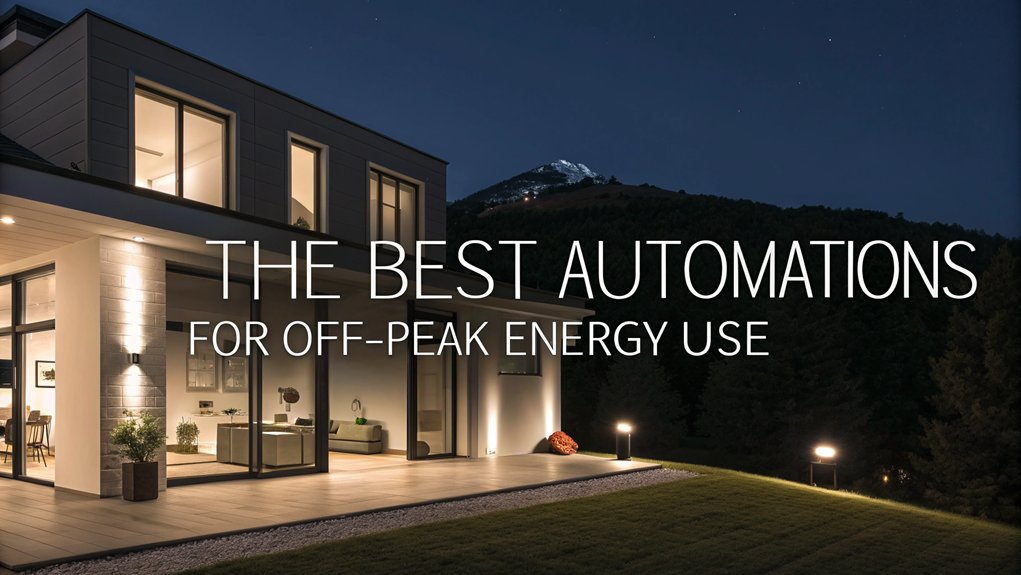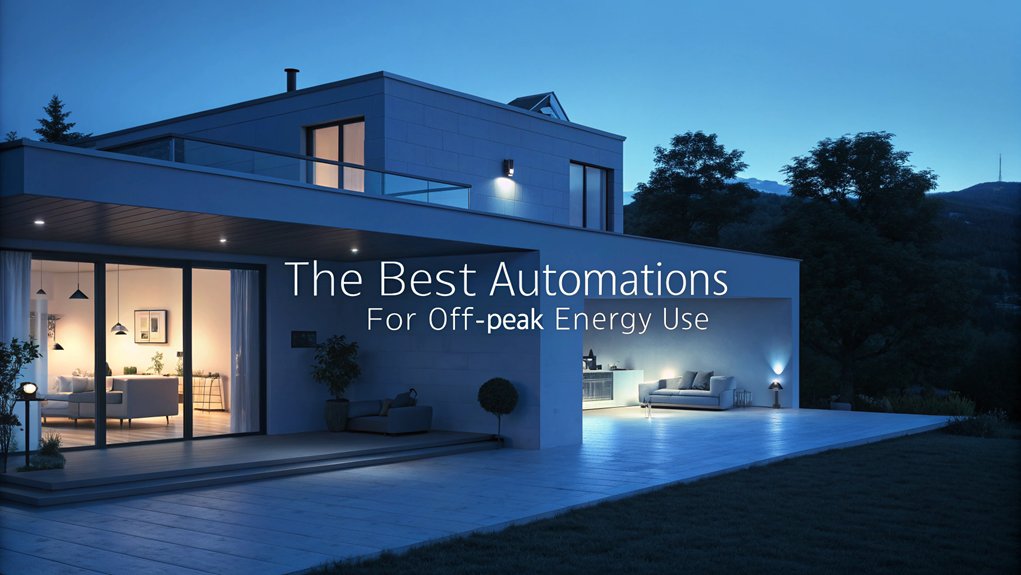To optimize energy efficiency during off-peak hours, automate your household appliances using smart technology. Schedule dishwashers and washing machines to run at night, saving up to 30% on energy costs. Use smart plugs to track and reduce phantom energy drain, saving $100-$200 annually. Charge electric vehicles during low-rate periods, trimming expenses by 10-30%. Smart thermostats can cut heating and cooling costs by 10-15%. Discover further insights into maximizing energy efficiency through automation.
Key Facts Summarized
- Automate dishwashers to run during off-peak hours, saving up to 30% on energy costs.
- Use smart plugs to schedule appliances for off-peak operation, reducing electricity expenses.
- Program washing machines for nighttime use to leverage lower energy rates.
- Implement smart electric vehicle chargers to automatically charge during off-peak times.
- Optimize heating and cooling systems with smart thermostats for energy-efficient performance.
Automating Dishwashers for Off-Peak Hours
When you automate dishwashers to run during off-peak hours, you considerably cut energy costs by leveraging lower electricity rates available at these times.
Smart dishwashers, integrated with home automation systems, allow you to monitor energy usage and schedule cycles efficiently. By operating during off-peak hours, you can reduce energy waste and save up to 30% on energy costs. Additionally, this strategy helps minimize phantom power consumption by ensuring devices are only active when necessary.
These energy-efficient models often include soil sensors, enhancing water and energy usage by adjusting cycles based on the load. This reduction in energy consumption further amplifies savings, especially when contrasted with standard models.
Automating the scheduling of your dishwasher guarantees it runs at ideal times, providing an effective strategy to enhance household energy efficiency and minimize unnecessary energy expenditure.
Scheduling Washing Machines for Nighttime Use
By strategically scheduling your washing machine to run during nighttime hours, you can leverage lower electricity rates and markedly reduce your energy costs.
Electricity is cheaper from 08:00 PM to 07:00 AM on weekdays and after 01:00 PM on Saturdays. Utilizing smart plugs or programmable washing machines allows you to automate laundry cycles during these off-peak hours, optimizing energy consumption.
An average washing machine uses up to 1.3 kWh per load, so scheduling multiple loads can yield substantial savings. Many modern washing machines include delay start features, enabling precise scheduling for off-peak periods. Additionally, actively engaging with your energy consumption habits can lead to further savings, as identified by the user engagement in whole-home energy monitors.
Optimizing Electric Vehicle Charging Times
After optimizing your laundry schedule to save on energy costs, it’s time to explore how electric vehicle (EV) charging can also benefit from off-peak energy strategies.
Charging during off-peak hours can cut your charging expenses by 10-30%, thanks to lower electricity rates. Many utility companies offer off-peak charging plans that smart devices can leverage to maximize savings.
Smart chargers automatically initiate charging during these times, enhancing energy efficiency without manual effort. This automation not only benefits your wallet but also reduces strain on the electrical grid during peak demand. Additionally, some EVs allow you to set charging schedules based on utility rates, streamlining automated energy use and contributing to sustainability. Furthermore, by utilizing smart meter technology, you can gain insights into your energy consumption patterns, promoting more informed charging decisions.
Embrace these technologies for optimized, cost-effective charging.
Integrating Smart Plugs for Energy Efficiency
Leveraging smart plugs is a strategic move to enhance energy efficiency in your home. By integrating smart plugs, you can greatly reduce energy consumption by controlling devices remotely.
These plugs eliminate phantom energy drain, saving you $100-$200 annually. They allow you to schedule appliances to run during off-peak hours, capitalizing on lower energy rates.
Smart plugs provide energy usage tracking, letting you analyze energy usage patterns and automatically adjust the temperature for devices like heaters and fans.
With smart lighting control, you can lower energy use even further. Integrating smart plugs with your HVAC system optimizes its operation by ensuring it runs efficiently, only when needed.
These insights empower you to make informed decisions, driving down electricity costs effectively. Additionally, monitoring capabilities help track usage and identify energy-hogging appliances, leading to further savings.
Utilizing Home Assistant for Real-Time Tariff Adjustments
Integrating smart plugs lays the groundwork for significant energy savings, yet maximizing efficiency requires a more dynamic approach.
Home Assistant empowers you to automate tariff switching and make real-time adjustments for energy management. By using time-based triggers, you can seamlessly shift between peak and off-peak periods, optimizing energy consumption.
Implement YAML coding to automatically adjust device settings according to current tariffs, reducing energy costs and enhancing your smart home’s energy-efficient operations. Additionally, regularly reading the meter will help you better understand your consumption patterns and improve your automation strategies.
Utilize the utility-meter integration with Shelly 3EM for monitoring real-time energy consumption, enabling informed decisions during peak demand.
- Automate tariff switching with time-based triggers.
- Leverage YAML scripts for cost-effective energy management.
- Monitor energy consumption using Shelly 3EM.
- Reduce peak demand energy usage.
- Enhance smart home efficiency with real-time adjustments.
Smart Control of Heating and Cooling Systems
How effectively can you manage heating and cooling costs in your smart home?
Smart thermostats provide a data-driven approach to optimize energy use. By learning your habits and adjusting temperatures automatically, they can save you 10-15% annually on heating and cooling.
Using programmable thermostats, you can schedule adjustments during off-peak hours, greatly reducing energy consumption and utility bills. Automation systems guarantee your air conditioning operates mainly when energy rates are lower, maximizing energy savings.
Regular maintenance enhances energy-efficient smart performance, preventing costly breakdowns. Integrating smart technology allows for remote control of your energy settings, ensuring you can optimize energy use from anywhere.
This strategic control of your energy consumption not only saves money but also reduces your carbon footprint.
Enhancing Lighting Efficiency With Automated Scheduling
When aiming to enhance lighting efficiency in your home, automating lighting schedules to coincide with off-peak energy times is a strategic move.
By optimizing your usage with smart technology, you can cut your average annual lighting cost of $147 by 50-80%.
Implement smart light bulbs and switches to schedule your lighting during off-peak hours, minimizing waste.
Integrate motion sensors to automatically switch off lights in unoccupied rooms, further boosting energy savings.
Shift to energy-efficient LED smart bulbs, which use 75% less energy than traditional alternatives, to maximize efficiency.
Utilize remote control systems to adjust settings based on your routines.
- Automating lighting schedules
- Smart light bulbs save energy
- Off-peak energy times utilization
- Minimize waste with motion sensors
- Energy-efficient LED smart bulbs
Frequently Asked Questions
How Do I Get the Most off Peak Electricity?
To maximize off-peak electricity usage, invest in smart appliances that program themselves based on real-time energy pricing.
Schedule water heaters and dishwashers during off-peak hours; they consume substantial energy, costing about $381 annually.
Implement smart thermostats to optimize heating and cooling, saving 10-15% on costs.
Use smart plugs to schedule devices, eliminating phantom energy drains and saving $100-$200 yearly.
Analyze usage patterns and adjust accordingly for efficiency.
Does Automation Reduce Energy Consumption?
You’re exploring whether automation cuts energy use, and data confirms it does.
By automating devices to operate during off-peak hours, you leverage lower electricity rates, effectively reducing energy bills.
Smart thermostats adapt to your habits, cutting heating and cooling costs by up to 15%.
Smart plugs eliminate phantom energy, saving up to $200 annually.
Automated lighting and appliances further optimize usage, offering substantial energy and cost savings.
What Is the Best off Peak Time to Use Electricity?
You should focus on using electricity during off-peak times, typically Monday to Friday from 8:00 PM to 7:00 AM, and weekends from Saturday 1:00 PM to Monday 7:00 AM.
Analyzing your utility provider’s specific schedule is essential, as these periods can vary by region.
What Time Is Peak Power Usage?
Peak power usage typically occurs on weekdays between 07:00 AM and 08:00 PM.
During these hours, both residential and commercial activities spike, causing higher electricity demand.
On Saturdays, peak times shift slightly from 07:00 AM to 01:00 PM, reflecting increased energy consumption in the morning and early afternoon.
Recognizing these peak times allows you to analyze and strategize your energy usage, optimizing cost efficiency by shifting certain activities to off-peak hours.
Conclusion
By embracing these automations, you’ll channel the wisdom of Da Vinci’s precision and Einstein’s efficiency, optimizing your home’s energy use during off-peak hours. Data shows a significant reduction in energy costs and environmental impact when you schedule dishwashers, washing machines, and electric vehicles wisely. Smart plugs and real-time tariff adjustments further enhance efficiency. As with any well-oiled machine, integrating automated controls for heating, cooling, and lighting guarantees your home operates harmoniously within the energy grid.

